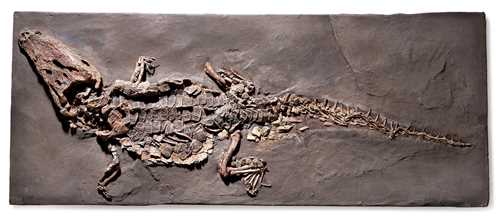
拍品 851* - A207 Out of This World - Montag, 04. Dezember 2023, 04.00 PM
FOSSIL CROCODILE
Crocodylia
Messel, Darmstadt, Germany
Eocene, circa 50 million years
55 × 135 × 9 cm
Messel, Darmstadt, Germany
Eocene, circa 50 million years
55 × 135 × 9 cm
Gutachten:
[Art.ArtText.Text@@5('[Art.BoId],21')]
[Art.ArtText.Text@@5('[Art.BoId],21')]
Provenienz:
[Art.ArtText.Text@@5('[Art.BoId],22')]
[Art.ArtText.Text@@5('[Art.BoId],22')]
Ausstellungen:
[Art.ArtText.Text@@5('[Art.BoId],23')]
[Art.ArtText.Text@@5('[Art.BoId],23')]
Ausstellung:
[Art.ArtText.Text@@5('[Art.BoId],24')]
[Art.ArtText.Text@@5('[Art.BoId],24')]
Literatur:
[Art.ArtText.Text@@5('[Art.BoId],25')]
[Art.ArtText.Text@@5('[Art.BoId],25')]
[Art.ArtText.Text@@5('[Art.BoId],26')]
Provenance: German private collection
In ancient times, advanced civilizations accorded significant reverence to crocodiles, often characterised by a profound mixture of fear, awe, and admiration. The Egyptians in particular held them in sacred esteem, honouring Sobek, their god symbolizing eternal continuity, depicted with a crocodile-headed human form. The origins of the 'true crocodiles', a group still extant in the wild today, can be traced back approximately 80 million years ago. Consequently, few species can rival the crocodile in representing evolutionary endurance and constancy.
The specimen under consideration hails from the renowned Messel Pit in Germany, a UNESCO World Heritage Site since 1995. Initially a site for petroleum extraction, the Messel Pit transitioned into an invaluable paleontological treasure trove post-mining. Countless excavations have yielded remarkably preserved fossils, including fish, small mammals, plants, and more. Owing to their exceptional preservation, these fossils provide invaluable insights into species diversity, environmental conditions, and the evolution of flora and fauna. Such discoveries have significantly enriched our comprehension of the Eocene ecosystem (56-33.9 million years ago).
Crocodilians (Crocodylia) constitute the contemporary representatives of the Crurotarsi lineage, a branch of archosaurs that diverged from the Ornithorida line, which includes pterosaurs and dinosaurs, around 250 million years ago during the early Triassic and early Mesozoic eras. Approximately 200 million years ago, this Crurotarsi lineage gave rise to phytosaurs, creatures bearing a striking resemblance in appearance and lifestyle to modern crocodilians. Remarkably, the crocodilian form has remained largely unchanged since that era, earning them the epithet of 'living fossils'.
The featured crocodile specimen eloquently exemplifies why they are often colloquially referred to as 'armored lizards'. The preservation of the intricate scale carapace enveloping the entire body is of exceptional quality, mirroring the specimen's overall state of preservation. The meticulous preparation reveals each scale and bone in exquisite detail. Upon closer examination, one notes subtle evolutionary vestiges, such as the presence of separate bony external nasal openings, which in contemporary crocodiles have fused into a single opening.
The fossilised crocodile also bears evidence of a life-altering injury in the form of a healed fracture on its right forefoot. This injury, marked by an irregular healing pattern and resulting bone misalignment, offers insights into the individual's regenerative response to a traumatic event endured during its lifetime.
According to the assessment of the Messel specialist at the Senckenberg Institute in Frankfurt, this specimen stands as the best-preserved fossil crocodile within their purview, a truly exceptional artefact in the annals of natural history
In ancient times, advanced civilizations accorded significant reverence to crocodiles, often characterised by a profound mixture of fear, awe, and admiration. The Egyptians in particular held them in sacred esteem, honouring Sobek, their god symbolizing eternal continuity, depicted with a crocodile-headed human form. The origins of the 'true crocodiles', a group still extant in the wild today, can be traced back approximately 80 million years ago. Consequently, few species can rival the crocodile in representing evolutionary endurance and constancy.
The specimen under consideration hails from the renowned Messel Pit in Germany, a UNESCO World Heritage Site since 1995. Initially a site for petroleum extraction, the Messel Pit transitioned into an invaluable paleontological treasure trove post-mining. Countless excavations have yielded remarkably preserved fossils, including fish, small mammals, plants, and more. Owing to their exceptional preservation, these fossils provide invaluable insights into species diversity, environmental conditions, and the evolution of flora and fauna. Such discoveries have significantly enriched our comprehension of the Eocene ecosystem (56-33.9 million years ago).
Crocodilians (Crocodylia) constitute the contemporary representatives of the Crurotarsi lineage, a branch of archosaurs that diverged from the Ornithorida line, which includes pterosaurs and dinosaurs, around 250 million years ago during the early Triassic and early Mesozoic eras. Approximately 200 million years ago, this Crurotarsi lineage gave rise to phytosaurs, creatures bearing a striking resemblance in appearance and lifestyle to modern crocodilians. Remarkably, the crocodilian form has remained largely unchanged since that era, earning them the epithet of 'living fossils'.
The featured crocodile specimen eloquently exemplifies why they are often colloquially referred to as 'armored lizards'. The preservation of the intricate scale carapace enveloping the entire body is of exceptional quality, mirroring the specimen's overall state of preservation. The meticulous preparation reveals each scale and bone in exquisite detail. Upon closer examination, one notes subtle evolutionary vestiges, such as the presence of separate bony external nasal openings, which in contemporary crocodiles have fused into a single opening.
The fossilised crocodile also bears evidence of a life-altering injury in the form of a healed fracture on its right forefoot. This injury, marked by an irregular healing pattern and resulting bone misalignment, offers insights into the individual's regenerative response to a traumatic event endured during its lifetime.
According to the assessment of the Messel specialist at the Senckenberg Institute in Frankfurt, this specimen stands as the best-preserved fossil crocodile within their purview, a truly exceptional artefact in the annals of natural history
To see this Object in a Video, click here
CHF 160 000 / 280 000 | (€ 164 950 / 288 660)
以瑞士法郎銷售 CHF 200 000 (包含買家佣金)
所有信息随时可能更改。







